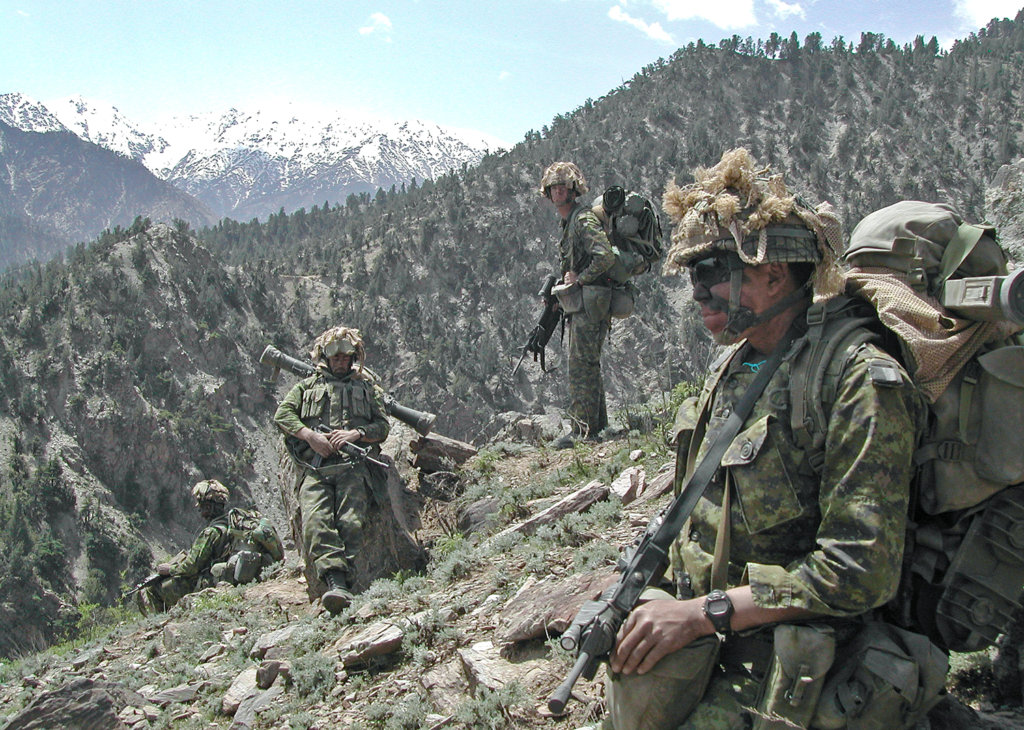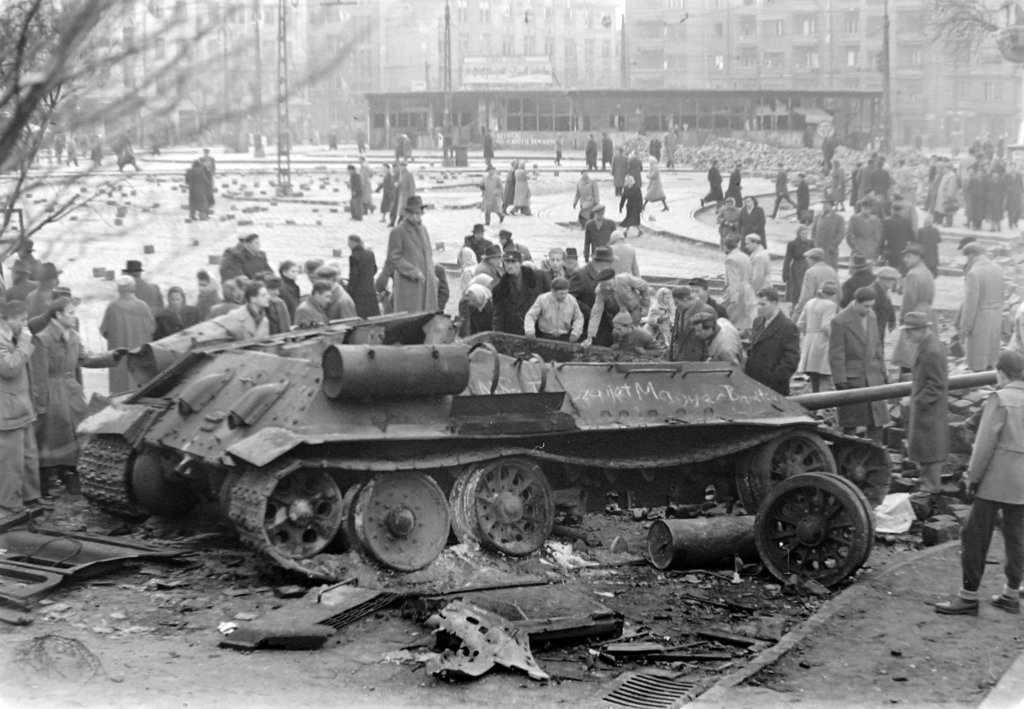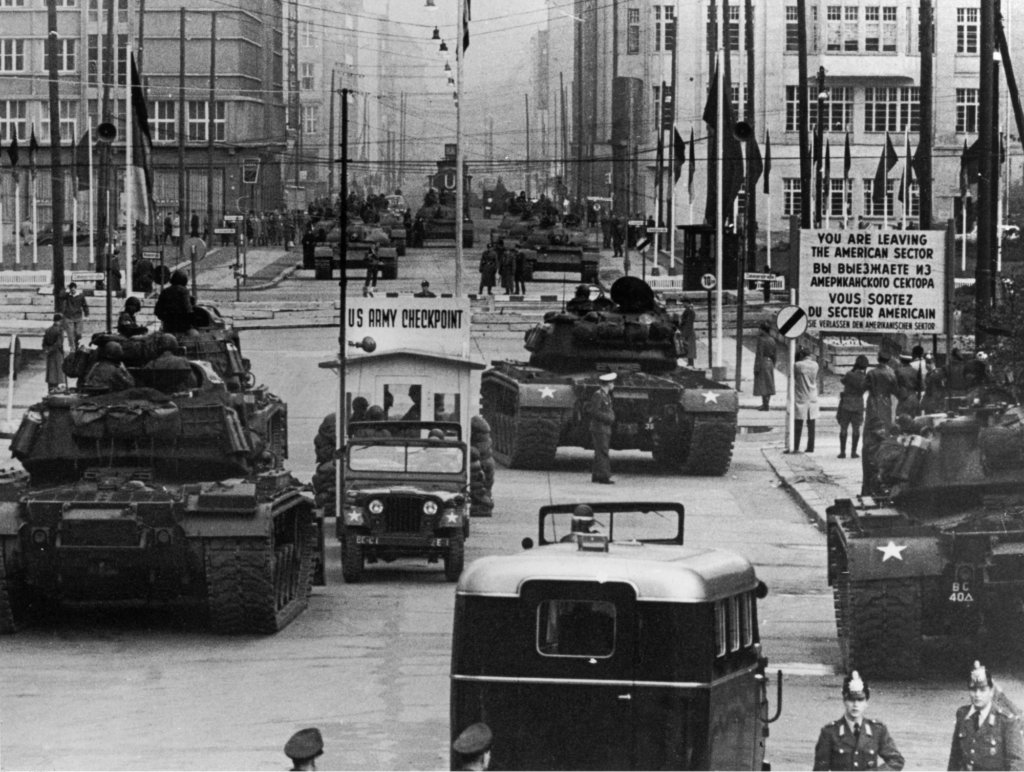
Canadian armoured reconnaissance troops with the 3RCR battle group patrol in the mountains west of Kabul in 2003.
[Stephen J. Thorne]
They qualify this by describing it as a time of “relative” peace, implying that the Cold War—four decades of living with the prospect of nuclear annihilation hanging over our heads—was a good thing and that regional conflicts are inconsequential.
As American as that might sound, the concept is not limited to our neighbours south of the 49th.
In 2012, the Norwegian Nobel Committee unanimously voted to award the European Union the Nobel Peace Prize for contributing to “the advancement of peace and reconciliation, democracy and human rights in Europe” for six decades.
This, in spite of the bitter ethnically and religiously based wars that raged in Eastern Europe, notably the Balkans and Chechnya, after the collapse of the Soviet Union and communism in the 1990s. Never mind the Hungarian Revolution of 1956 or the Soviet invasion of Czechoslovakia in 1968—mere incidents, apparently.
According to the Global Conflict Tracker, there are at least 26 hot wars and simmering conflicts in the world today, including the 17-month-old—some say nine-year-old—war in Ukraine; the potential powder keg developing over Chinese territorial claims in Taiwan and the South China Sea; and wars, civil wars and conflicts in Africa, the Middle East, the Indian subcontinent and Southeast Asia.
The Armed Conflict Location and Event Data Project reported 19 countries met the Index’s criteria for high or extreme levels of conflict severity at the start of 2023.
For the week of July 15 alone, it recorded 2,350 incidents of political violence worldwide, including battles. And that was down 16 per cent from the previous week.
Some 21.3 million people currently serve in armed forces around the world (China tops the list at 2.4 million, followed by the U.S. at 1.4 and India at 1.3). Fourteen of the world’s 20 largest militaries are in developing nations.
Two billion people currently live in conflict-affected areas and climate change is creating new reasons to go to war.
Humanity’s penchant to fight and kill one another is at least as old as recorded history. The New York Times reported in 2003 that humans had been entirely at peace for just 268 of the past 3,400 years, or an estimated eight per cent of humankind’s documented time on Earth, which spans about 5,000 years.
Estimates of the total number of people killed in wars over that time vary widely between 150 million and a billion.

Captain Americo Rodrigues, a medical officer with the 3R22R battle group, attends to patients in a remote mountain village northeast of Kabul in 2004.
[Stephen J. Thorne]
Between its founding in 1776 and 2020, America was at peace for all of 15 years, reported the news site Medium. It has been been involved in at least 105 wars and rebellions, four of which still involve U.S. forces: Niger, Syria, Somalia and Yemen.
In the history of our southern neighbour, more than 650,000 Americans have died in combat.
The Americans currently have between 160,000 and 170,000 active-duty personnel deployed in “non-combat” roles in at least 36 countries, nearly 40,000 of whom are assigned to classified missions and an additional, undetermined number participating in actual wars—more, apparently, than we know.
A November 2022 report by New York University School of Law’s Brennan Center for Justice says the Americans have been involved in many more wars over the past 20 years than the Pentagon has disclosed to Congress.
“Afghanistan, Iraq, maybe Libya,” says the report by the law and policy think tank. “If you asked the average American where the United States has been at war in the past two decades, you would likely get this short list.
“But this list is wrong—off by at least 17 countries in which the United States has engaged in armed conflict through ground forces, proxy forces, or air strikes. For members of the public, the full extent of U.S. war-making is unknown.”
And that includes American lawmakers. Congress’s understanding of its forces’ involvement in overseas wars, adds the 39-page report, is often no better than the public record. The U.S. defence department provides congressionally mandated disclosures and updates to a limited few.
“Sometimes, it altogether fails to comply with reporting requirements, leaving members of Congress uninformed about when, where, and against whom the military uses force. After U.S. forces took casualties in Niger in 2017, for example, lawmakers were taken aback by the very presence of U.S. forces in the country.”
Pax Americana, indeed.

Troops with the 3PPCLI battle group prepare to patrol in mountains on the Afghanistan-Pakistan border in 2002, at the time the last known location of Osama bin Laden. [Stephen J. Thorne]
In his 2017 paper Unipolarity, Hegemony, and the New Peace, Tulance University political scientist Christopher J. Fettweis contends that, despite some persistent, high-profile conflicts in the Middle East, the world is experiencing “an era of unprecedented peace and stability.”
Fettweis says what has been dubbed the “New Peace,” a quarter-century period of greater peace and stability after the Cold War ended, has shown continued improvements in related measurements such as the number of coups, the amount of repression, and the durability of peace settlements.
Some contend that U.S. hegemony was responsible for the Pax Americana. But Fettweis calls the evidence supporting their arguments “rather thin.”
“The New Peace can in all likelihood continue without US dominance and should persist long after unipolarity [a system founded on one great power] comes to an end,” he said.
In his 2011 book The Better Angels of Our Nature, Montreal-born Harvard psychologist Steven Pinker argues that there has been an extraordinary but little-recognized reduction in all forms of violence stretching back at least to 10,000 BCE.
According to Pinker, the decline has taken place in different periods in different parts of the world and there have been many reversals. But the overall trend, he argues, has clearly been downward—less warfare, fewer murders, dramatic reductions in torture and other cruel and inhumane practices, and the virtual eradication of slavery.

Hungarians crowd around a destroyed Soviet tank on a Budapest street in 1956. [Wikimedia]
First excavated in the 1960s, the cemetery at Jebel Sahaba was revisited in recent years by at team of paleoanthropologists, anthropologists, geochemists and prehistorians armed with new technologies and perspectives.
What they discovered was that the remains thought to have come from a single battle in fact died over the course of protracted warfare that took place at least 8,000 years before the rise of Egyptian civilization.
“Most trauma appears to be the result of projectile weapons and new analyses confirm for the first time the repetitive nature of the interpersonal acts of violence,” said the May 2021 study, headed by paleoanthropologist Isabelle Crevecoeur of the University of Bordeaux, France. “Indeed, a quarter of the skeletons with lesions exhibit both healed and unhealed trauma.
“We dismiss the hypothesis that Jebel Sahaba reflects a single warfare event, with the new data supporting sporadic and recurrent episodes of interpersonal violence, probably triggered by major climatic and environmental changes.”
The conflicts took place at the end of the Late Pleistocene and beginning of the Holocene periods, whose climatic changes included a major drought.
While the researchers cannot definitively say what caused the fighting, they noted that such climate extremes would have affected food, water and other resources.
They suspect different groups of people who were once distributed across a wide area sought refuge from the harsh climes in the Nile Valley, where wildlife would have been more plentiful—and competition more intense as the region became more populated. Later flooding from an overflowing Lake Victoria would only have exacerbated their problems, escalating tensions and, thus, the potential for conflict.
American science fiction author Joe Haldeman, himself a wounded Vietnam veteran, has written extensively on war, drawing on his own experiences in his celebrated 1974 novel The Forever War and addressing age-old questions about the human condition.
“Maybe war is an inevitable product of human nature,” he once wrote. “Maybe to get rid of war, we have to become something other than human.”

American and Soviet tanks face off at Checkpoint Charlie in Berlin in 1961.
[US Army/WIkimedia]
Advertisement


















